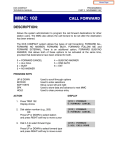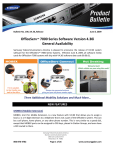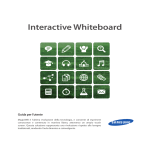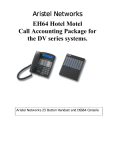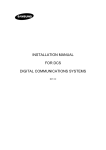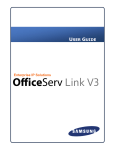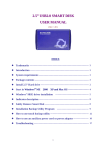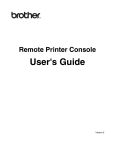Download OfficeServ Web MMC User Manual
Transcript
WebMMC User Manual Every effort has been made to eliminate errors and ambiguities in the information contained in this guide. Any questions concerning information presented here should be directed to SAMSUNG TELECOMMUNICATIONS AMERICA, 1301 E. Lookout Dr. Richardson, TX. 75082 telephone (972) 7617300. SAMSUNG TELECOMMUNICATIONS AMERICA disclaims all liabilities for damages arising from the erroneous interpretation or use of information presented in this guide. Samsung Telecommunications Publication Information SAMSUNG TELECOMMUNICATIONS AMERICA reserves the right without prior notice to revise information in this publication for any reason. SAMSUNG TELECOMMUNICATIONS AMERICA also reserves the right without prior notice to make changes in design or components of equipment as engineering and manufacturing may warrant. Copyright 2006 Samsung Telecommunications America All rights reserved. No part of this manual may be reproduced in any form or by any means—graphic, electronic or mechanical, including recording, taping, photocopying or information retrieval systems— without express written permission of the publisher of this material. Trademarks is a trademark of SAMSUNG Telecommunications America, L.P. WINDOWS 95/98/XP/2000 are trademarks of Microsoft Corporation. PRINTED IN USA INTRODUCTION Purpose OfficeServ WebMMC is a web-based application used to configure the OfficeServ 7400 keyphone system. This document describes the installation method, the main features, and programming methodology of OfficeServ WebMMC. Document Content and Organization This guide is composed of three chapters and a listing of abbreviations, which can be summarized as follows: CHAPTER 1. Introducing OfficeServ WebMMC This chapter introduces the background and purpose of WebMMC along with pre-installation checks, and detailed steps to install the product. CHAPTER 2. Getting Started With OfficeServ WebMMC This chapter explains how to launch WebMMC and access the web application. CHAPTER 3. Programming With OfficeServ WebMMC This chapter details the web application’s user interface and how to navigate the program. ABBEVIATIONS This section contains definitions for all abbreviations used in the manual. 1 Document Conventions The following paragraph notices contain specialized information that should be carefully examined in order to more fully understand the product. CAUTION These sections outline critical information or instructions that must be observed to prevent damage or corruption. CHECKPOINT These sections outline specific items that can be checked to verify proper implementation and behavior of the program. NOTE These sections are not service affecting, but are informational tips and explanations to further assist in understanding the product. References OfficeServ 7400 General Description OfficeServ 7400 System Manual introduces the OfficeServ 7400 keyphone system and describes system overview information such as hardware configurations, specifications, and functions. OfficeServ 7400 Installation Manual OfficeServ 7400 Installation Manual describes the processes involved in installation, configuration, verification, and operation of the OfficeServ 7400 keyphone system. OfficeServ 7400 Programming Manual OfficeServ 7400 Service Manual details the features and methodologies of the system software, along with detailed programming descriptions and tgroubleshooting information for the OfficeServ 7400 keyphone system. Revision History EDITION DATE OF ISSUE REMARKS 00 6. 2006 First Edition 2 Installing or Uninstalling OfficeServ WebMMC CAUTION When installing or uninstalling OfficeServ WebMMC the Operating System will be required to restart. As such, be sure to save all data and exit all programs before launching the installer or uninstaller. The installation program can overwrite old data, so in the case of reinstallation, be sure to back up existing data first. 3 TABLE OF CONTENTS INTRODUCTION 1 Purpose ......................................................................................................................... 1 Document Content and Organization............................................................................. 1 Document Conventions ................................................................................................. 2 References .................................................................................................................... 2 Revision History............................................................................................................. 2 Caution ...........................................................................................................................3 CHAPTER 1. Introducing OfficeServ WebMMC 5 OfficeServ WebMMC Introduction.................................................................................. 5 System Requirements.................................................................................................... 6 Installation Process Overview........................................................................................ 8 Installing the Java Runtime Environment....................................................................... 8 Installing the Tomcat .................................................................................................... 10 Installing OfficeServ WebMMC .................................................................................... 14 CHAPTER 2. Getting Started With OfficeServ WebMMC 18 Launching OfficeServ WebMMC Overview.................................................................. 18 Launching Apache Tomcat........................................................................................... 18 Launching OfficeServ WebMMC.................................................................................. 20 Logging in to the WebMMC Web Application............................................................... 21 CHAPTER 3. Programming with OfficeServ WebMMC 22 Home Page Layout ...................................................................................................... 22 Account Information..................................................................................................... 23 Administration .............................................................................................................. 24 Connecting to a Live System ....................................................................................... 25 Opening an Offline Database File ................................................................................ 26 Working with OfficeServ WebMMC.............................................................................. 27 Downloading a System Database................................................................................ 28 Uploading a System Database .................................................................................... 29 ABBREVIATIONS 30 H ~ T .......................................................................................................................... 30 4 CHAPTER 1. Introducing OfficeServ WebMMC OfficeServ WebMMC Introduction OfficeServ WebMMC is a web based application used to configure programming options in the OfficeServ 7400 keyphone system. In the past, Samsung keyphone systems were programmed using Keyset Man-Machine Code (KMMC) using a system keyset. Over time this style of programming was supplemented by personal computer-assisted programming, or PCMMC. The most recent Samsung keyphone systems have an even more evolved PCMC solution called the OfficeServ Manager, or OSM, which is a client-side Windows-based application.OfficeServ WebMMC improves upon OSM by allowing a technician to configure the system over the web using the Internet Explore browser. OfficeServ WebMMC communicates via the Transmission Control Protocol/Internet Protocol(TCP/IP) with the keyphone system. The web application is delivered to technicians through Apache Tomcat, an industry standard open-source web server. Technicians connect to OfficeServ WebMMC server and login by using a unique user ID and password, as controlled by the web server administrator. OfficeServ WebMMC has the ability to create, open, and modify an OfficeServ 7400 keyphone system database offline, with no active conection to a system. OfficeServ WebMMC can also connect to an OfficeServ 7400 keyphone system live in order to upload or download databases or make live programming changes. 5 System Requirements Before installing or using OfficeServ WebMMC ensure that the computers to be used meet the minimum requirements specified below. Server PC Requirements Item Specification CPU Intel Pentium IV 2 GHz or higher Main Memory 1 GB RAM or higher Operation System Microsoft Widows 2000 Series (SP3 or higher), Microsoft Widows XP Professional (SP1 or higher), Microsoft Widows 2003 Network Interface Card 10/100 Base-T Web Browser Internet Explorer 6.0 or higher HTTP Processor Tomcat 5.5 or higher Java Container Java Runtime Environment 5.0 or higher JSP Server Tomcat 5.5 or higher Client PC Requirements Item Specification CPU Intel Pentium IV 1 GHz or higher Main Memory 256 MB RAM or higher Operation System Microsoft Widows 2000 Series (SP3 or higher), Microsoft Widows XP Home (SP1 or higher), Microsoft Widows XP Professional (SP1 or higher) Network Interface Card 10/100 Base-T Web Browser Internet Explorer 6.0 or higher OfficeServ Keyphone System Requirements Cabinet OfficeServ 7400 Software 3.31b or higher Client / Server Configuration Although system specifications define both a server and a client PC, one PC can act as both server and client. In these cases the system must meet the server requirements listed above. 6 OfficeServ WebMMC Configuration OfficeServ WebMMC can be configured as a standalone server, or as a web server to support multiple client logins. The following illustrations demonstrate the difference between the two. Standalone Server When configured as a standalone server, OfficeServ WebMMC is installed on the technician’s PC or laptop. In this setup the technicians is given maximum serviceability, as connection to the switch does not require interfacing to an outside webserver. Web Server OfficeServ WebMMC Apache Tomcat Internet Explorer LAN OfficeServ 7400 Web Server When configured as a web server, OfficeServ WebMMC is installed on an internet accxessible PC. In this configuration a technician does not even require a laptop. They can use an PC that has Internet Explorer installed to access the WebMMC server. In this configuration the customer site network firewall would have to allow the both the PC in question and the OfficeServ keyphone system to have internet access. Tech PC 1 Internet Explorer LAN Web Server OfficeServ WebMMC Apache Tomcat OfficeServ 7400 7 Installation Process Overview The steps to install OfficeServ WebMMC are as follows: 1. Install the Jave Runtime Environment. 2. Install Apache Tomcat. 3. Install OfficeServ WebMMC. Installing the Java Runtime Environment The Java Runtime Environment, or J2SE, is a standalone Java platform that allows Java applications to run on the server. The J2SE platform is required in order to install Apache Tomcat. 1. Locate the J2SE installation file included with OfficeServ WebMMC, ‘jre-1_5_0_06windows-i586-p.exe’, or download the most current J2SE installation package from ‘http://java.sun.com/javase/’. 2. Double-click the installation file to launch the installer. 3. Carefully read the license agreement and click [Accept >] . 8 4. 5. The J2SE installation will begin. When the installation of the Java Runtime Environment is completed, click [Finish] to exit the installer. 9 Installing the Tomcat Apache Tomcat is a web container that runs on the J2SE platform. Tomcat includes an HTTP processor, a Java servlet, and a JavaServer Pages, or JSP, compiler. Tomcat acts as both server and interpreter for the OfficeServ WebMMC web application. 1. Locate the Tomcat installation file included with OfficeServ WebMMC, ‘apachetomcat-5.5.15.exe’, or download the most current Tomcat installation package from ‘http://tomcat.apache.org/’. 2. Double-click the installation file to launch the installer. Click [Next >]. 3. Carefully read the license agreement and click [I Agree]. 10 4. Choose the items to install, or accept the defaults, and click [Next >]. 5. Choose the installation path, or accept the default, and click [Next >]. 11 6. 7. Set up the Tomcat connector port and the administrator login and click [Next >]. The connector port defines how a technician will connect to the web page, and defaults to 8080. The administrator login is only used for remote administration of Tomcat, and has no effect on OfficeServ WebMMC. The installer will attempt to locate the J2SE path. If it cannot be found, or if multiple installations are found, the correct path will have to be set manually. When it is located, click [Next >]. 12 8. 9. Installation will begin with the chosen options. Click Show Details to see a more in-depth file-by-file progress report. Once installation has completed uncheck the ‘Run Apache Tomcat’ checkbox and click [Finish] to exit the installer. Run Apache Tomcat By default, the Tomcat installer will be set to launch Tomcat after exiting. If Tomcat is running during the OfficeServ WebMMC installation, Tomcat will have to be restarted before WebMMC will function. 13 Installing OfficeServ WebMMC After installing J2SE and Tomcat, OfficeServ WebMMC can be installed. The WebMMC isntaller will set up both the WebMMC COM object and the web application. 1. Locate the WebMMC installation file, ‘OfficeServ WebMMC(20060504).zip’, or download the most current WebMMC installation package from ‘http://www.samsunggsbn.com/’. 2. Extract the setup file and double-click the ‘setup.exe’ file to launch the installer. 3. The installer will search for Apache Tomcat. When it is found, click [Yes]. 4. When the welcome screen appears, click [Next >]. 14 5. Select a country and click [Next >]. 6. Carefully read the license agreement and click [Yes]. 15 7. Set the destination folder and click [Next >]. 8. To begin installation click [Install]. 16 9. The progress screen will appear and beging copying files. 10. During installation the C Runtime Library 6.0 will also be installed. 11. Once all files are copied an alert will appear warning that Tomcat must be restarted if it is running. 12. Click [Finish] to complete OfficeServ WebMMC installation. 17 CHAPTER 2. Getting Started With OfficeServ WebMMC Launching OfficeServ WebMMC Overview The steps to launch OfficeServ WebMMC are as follows: 1. Launch Apache Tomcat. 2. Launch OfficeServ WebMMC. 3. Log in to the WebMMC web application. Launching Apache Tomcat Because Tomcat acts as both web server and interpreter for OfficeServ WebMMC, it must be running before WebMMC can be started. 1. Click on [Start] Æ [Programs] Æ [Apache Tomcat x.x] Æ [Configure Tomcat]. When the dialog opens, click [Start]. To have Tomcat start automatically with Windows, set ‘Startup Type’ to ‘Automatic’. Click [OK] to close the window. 18 2. 3. To verify that Tomcat is running successfully, open Internet Explorer and in the ‘Address’ field type ‘http://localhost:8080/’ and press [Enter]. The Tomcat default home page will be displayed. Starting Tomcat If the Tomcat home page does not start, repeat step 1 to verify that the service is running. If the home page still fails to load, verify that the anonymous internet guest account, IUSR_<computername>, has read/write access to the Tomcat directory, ‘C:\Program Files\Apache Software Foundation’. 19 Launching OfficeServ WebMMC Although the main programming interface for WebMMC is the web application, there is also a server-side program that must be running in order to log in to the web application. 1. 2. On the Windows Desktop locate the OfficeServ WebMMC shortcut and double-click it. The OfficeServ WebMMC command line tool will launch in a DOS window similar to the one below. Verify that the display shows ‘Waiting for next client to connect…’. Starting OfficeServ WebMMC If the WebMMC windows does show ‘Waiting for next client to connect…’ it indicates a problem initializing the NIC interface. Analyze any error messages shown to diagnose the problem, and contact Samsung Technical Support if necessary. OfficeServ WebMMC Communications Interface The OfficeServ WebMMC program is a command line program, and must remain running in order to log in to the web interface. Closing the window will exit the program, so be sure to keep the window running at all times. The program can be minimized by clicking the _ button in the upper right. 20 Logging in to the WebMMC Web Application The WebMMC web application is the interface for the program where all switch programming is done. 1. 2. 3. Open Internet Explorer and in the address field type ‘http://localhost:8080/webmmc’ and press enter. The WebMMC login screen should be diplayed. The default login is ‘admin’ with a password of ‘4321’. The main OfficeServ WebMMC home page will be displayed. Logging in to WebMMC If the WebMMC login screen does not display, or does nto display properly, verify that the version of Internet Explorer is 6.0 or higher. Also verify that the current user account and the IUSR_<computername> account have read/write access to the Tomcat folder, ‘C:\Program Files\Apache Software Foundation’. Logging in from another computer The ‘localhost’ designation can only be used from the PC that has WebMMC installed. To connect to this web page from another destination, enter the IP address or computer name in place of localhost. (e.g. – ‘http://192.168.1.0:8080/webmmc’ or ‘http://WebMMCSrvr:8080/webmmc’) 21 CHAPTER 3. Programming with OfficeServ WebMMC Home Page Layout The OfficeServ WebMMC web application home page provides access to all of the features of WebMMC. HOME User ID Program Information Connection Type Administration 22 MY INFO HELP LOGOUT Feature Description HOME Loads the WebMMC home page. MY INFO Configure user account. HELP Displays the help page. LOGOUT Logs the user out of WebMMC. User ID Displays the ID of the currently log-in user. Program Information - Version: Displays WebMMC version information. - Connection Status: Displays the current connection status: x Idle: No systems connected and offline files open. x Offline: Currently viewing an offline database. x Online: Currently connected to a system. - File Name: Displays the filename of the open offline database. - System: Displays IP address of the system currently connected. - Switch: Displays switch type and country Online / Offline / Disconnect - Online: Loads switch connection page. - Offline: Loads saved database connection page. - Disconnect: Disconnect from system or closes database file. Administration Loads user management page. Account Information The MY INFO page is used to set up information about the current user account. 1. Click [MY INFO] to load the Change User Information page. 2. Enter the details that are to be changed and click [OK]. 23 Administration The Administration page is used to manage OfficeServ WebMMC user accounts. This page can only be loaded when logged in as ‘admin’. The Administration page is accessed by clicking [Configuration] then [User Information]. Screen Items Descriptions User ID The user ID and permissions level. State / Connection The current status of the user account. IP Address The IP address of the most recent login for the user account. Connect URL The IP address of the system the user Is connected to, or the name of the offline database being viewed by the user. Initialize Password Resets the password for the selected account(s) to ‘4321’. Delete Delete the selected user account(s). Select All Select all user accounts. Cancel Clears current user account selection. Add Create user account from the entered user ID 24 Connecting to a Live System The On-Line page is used to establish a connection to a live system. To access the page, click [Online]. Screen Items Descriptions Site Name The name of the system site. Link Type System connection method (IPv4 / IPv6 / Modem) Site Number IP address of the system. Tenant Determines the tenant number to connect to. Password Sets the password used to log in to the system. Connect Attempt to log in to the selected system. Delete Delete the selected system. Select All Select all systems. Cancel Clears current system selection. Add Create a new system selection from the entered information. 25 Opening an Offline Database File The Off-Line page is used to open a previously downloaded database. To access the page, click [Offline]. Offline database files are Access mdb files, and are stored in ‘C:\Program Files\Samsung Electronics\OfficeServ Webmmc\DB_USER’. Screen Items Descriptions Database File Name The file name for this database Password The password used to log in to the database. Open Attempt to open and log in to the selected database. Delete Delete the selected database file. Select All Select all databases. Cancel Clears current database selection. Create Create a new system selection from the entered information Country For new database files. Select the installation country. Cabinet 2/3 Kind For new database files. Select the type of add-on cabinet. 26 Working with OfficeServ WebMMC The system programming pages for OfficeServ WebMMC Options MMC List Page Navigation Feature Description Icon -Save: Saves the MMC to system or database file. -Reload: Refresh the current MMC from system / database file. -Copy: Copy the currently selected value for future use -Paste: Paste the previously copied selection. To paste to multiple cells, click the first cell, then click the last cell, and then click Paste. Paste can only copy vertically or horizontally, not both at the same time. -Repeat: Repeat is used to fill a series of cells with consecutive numbers (e.g. 2001, 2002, 2003…2095). To use the Repeat feature, click the first cell, then the last cell, and then click Repeat. Enter the starting number and choose to number forward (up) or backward (down). MMC List Lists all MMCs available to this system. Page Navigation Some large MMCs are broken down in to multiple pages. The Page Navigation links are used to move between pages. MMC Descriptions For a list of MMCs and their functions refer to the ‘OfficeServ 7400 Programming Manual’. 27 Downloading a System Database This process is used to download a full or partial image of the system database to a file. 1. 2. 3. 4. Click [All Up/Download] then [All Download]. Choose the existing database to save to and click [Open] or enter details to create a new file and click [Create]. The MMC selection window will appear. Select the appropriate MMCs to download and click [OK]. By default all MMCs are downloaded. A progress screen will be displayed. Once download has completed any errors will be displayed, or a success message will appear. 28 Uploading a System Database This process is used to upload a full or partial database from a file to a live system. 1. Click [All Up/Download] then [All Upload]. 2. Choose the existing database to save to, enter the password, and click [Open]. 3. 4. The MMC selection window will appear. Select the appropriate MMCs to upload and click [OK]. By default all MMCs are uploaded. A progress screen will be displayed. Once upload has completed any errors will be displayed, or a success message will appear. 29 ABBREVIATIONS H HTTP Hyper Text Transfer Protocol IIS Internet Information Services I J J2SE Java 2 Second Edition JRE Java Runtime Environment LAN Local Area Network MMC Man-Machine Code OS Operating System TCP/IP Transmission Control Protocol/Internet Protocol L M O T 30
































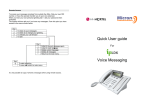
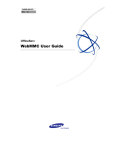
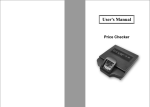
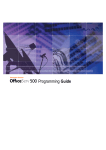
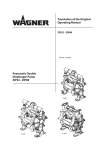
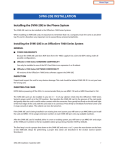
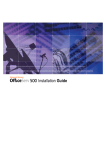

![SamsungProdBulletin_211_4_4x_Software_Release[1]](http://vs1.manualzilla.com/store/data/005825179_1-598976db56b1ef1012f4b9b7fb2b917f-150x150.png)
